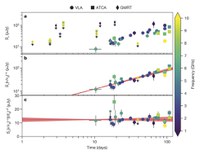Solving the Mystery of Gravitational-wave EM Sources
 GW170817 was the first gravitational-wave detection of a binary neutron-star merger. This event was accompanied by radiation across the electromagnetic spectrum and localized to the galaxy NGC 4993 at a distance of 40 Megaparsecs. It has been proposed that the observed γ-ray, X-ray and radio emission is due to an ultra-relativistic jet being launched during the merger successfully breaking out of the surrounding material, directed away from our line-of-sight. The presence of such a jet is predicted from models that posit neutron-star mergers as the drivers of short hard γ-ray bursts. In this contribution, Mooley et al. report that the radio light curve of GW170817 has no direct signature of the afterglow of an off-axis jet. Although the existence of a jet directed away from the line of sight cannot be completely ruled out, the observed γ-ray emission could not have originated from such a jet. Instead, the radio data require the existence of a mildly relativistic wide-angle outflow moving towards Earth. This outflow could be the high-velocity tail of the neutron-rich material that was ejected dynamically during the merger, or a cocoon of material that breaks out when a jet launched during the merger transfers its energy to the dynamical ejecta. Because the cocoon model explains the radio light curve of GW170817, as well as the γ-ray and X-ray emission, and possibly also the ultraviolet and optical emission, it is the model that is most consistent with the observational data. Cocoons may be a ubiquitous phenomenon produced in neutron-star mergers, giving rise to a hitherto unidentified population of radio, ultraviolet, X-ray and γ-ray transients in the local Universe.
GW170817 was the first gravitational-wave detection of a binary neutron-star merger. This event was accompanied by radiation across the electromagnetic spectrum and localized to the galaxy NGC 4993 at a distance of 40 Megaparsecs. It has been proposed that the observed γ-ray, X-ray and radio emission is due to an ultra-relativistic jet being launched during the merger successfully breaking out of the surrounding material, directed away from our line-of-sight. The presence of such a jet is predicted from models that posit neutron-star mergers as the drivers of short hard γ-ray bursts. In this contribution, Mooley et al. report that the radio light curve of GW170817 has no direct signature of the afterglow of an off-axis jet. Although the existence of a jet directed away from the line of sight cannot be completely ruled out, the observed γ-ray emission could not have originated from such a jet. Instead, the radio data require the existence of a mildly relativistic wide-angle outflow moving towards Earth. This outflow could be the high-velocity tail of the neutron-rich material that was ejected dynamically during the merger, or a cocoon of material that breaks out when a jet launched during the merger transfers its energy to the dynamical ejecta. Because the cocoon model explains the radio light curve of GW170817, as well as the γ-ray and X-ray emission, and possibly also the ultraviolet and optical emission, it is the model that is most consistent with the observational data. Cocoons may be a ubiquitous phenomenon produced in neutron-star mergers, giving rise to a hitherto unidentified population of radio, ultraviolet, X-ray and γ-ray transients in the local Universe.
Image: [a] The flux densities Sν correspond to the detections (markers with 1σ error bars) and upper limits (downward-pointing arrows) of GW170817 from 0.6 – 15 GHz (black for ≤1 GHz; yellow for ≥10 GHz) between days 16 and 107 after the merger. The marker shapes denote measurements from different telescopes. [b] Same as a, but with flux densities corrected for the spectral index α = −0.61and with early-time, non-constraining upper limits removed. The light curve fit with temporal index δ = 0.78 is the red line and the uncertainty in δ (±0.05) as the red shaded region. [c] Residual plot after correcting for the spectral and temporal variations.
Publication: K.P. Mooley (Oxford, NRAO, California Institute of Technology) et al., A Mildly Relativistic Wide-angle Outflow in the Neutron-star Merger Event GW170817, 8 February 2018, Nature, 554, 207.




Connect with NRAO